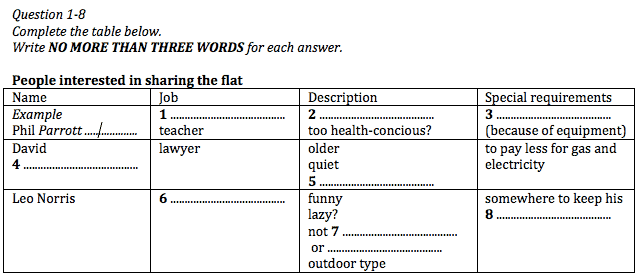How To Do IELTS Listening Note/Form/Table/Chart Completion Questions
Remember, the IELTS listening test has 4 parts each with 10 questions and lasts for 30 minutes in total. After that you will then have 10 minutes to move your answers to the answer sheet provided.
- Part 1 is a general conversation between 2 people.
- Part 2 is a monologue with just one person talking about a general topic.
- Part 3 is an everyday conversation between 2-3 people.
- Part 4 is one speaker giving an academic lecture.
Note/Form/Table/Chart Completion in the IELTS listening test are often more difficult than they should be. This is how they might appear:

Below is my step by step guide on how to do IELTS Note/Form/Table/Chart Completion listening questions:
1.Read all of the question instructions carefully paying attention to any word limit given.
2.Take a moment to understand the rest of the note/form.
3.Think about synonyms for words on the form.
4.Use the information given to predict the types of answers you should be listening for.
5.Listen carefully and fill in the missing information.
6.Guess if you need to and then move on.
Tips and Tricks
Usually these types of questions require you to write in facts and figures such as times and dates.
As you should know what type of information you are listening for you should be ready for when you do hear it.
You will often hear more than one piece of information that could fit the gap though, so do not just write in the first time or date that you hear.
Sometimes the speaker will correct their own answer meaning that the first response they gave was incorrect. For example: 'The bus leaves at 6.30 pm. Oh wait a minute, no it doesn't it leaves at 6.40 pm.' So, watch out for this trick!
A Few More Ideas To Help:
Sometimes between recordings there is an opportunity for a short break. Avoid using this time to check previous answers and instead use this to read ahead and understand the upcoming multiple choice questions.
Don’t get ‘held up’ on one question if you are not sure, make your best guess and be ready for the next question.
If you hear words such as, ‘even though’, ‘but’, or ‘however’ then this can be a sign that the meaning of a sentence is going to be modified in some way which may affect your choice.
And finally, make sure you are clear on the the steps you are going to go through when answering each IELTS listening question type. Practicing the steps will give you confidence and help you remain calm on test day AND hopefully boost your score!
Free IELTS Listening Samples And Practice Tests
A full online version of the listening test from the British Council.
IELTS Writing Task 1 (Academic)
Discover how to describe all types of visual data that you may see in this part of the test.
Sshhhhh! Listen closely, here are some valuable tips, techniques and strategies for maximising your listening band score.
IELTS Writing Task 1 (General)
Discover how to write in the correct format and tone for this part of the test.
Learn 'what' to say and 'how' to say it in each part of the test to impress the examiner.






